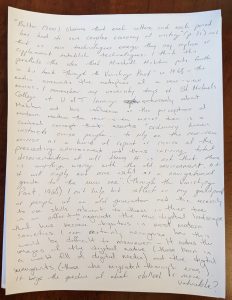
Analysis
Much of the writing I do, both personally and professionally, is done by typing on my laptop. With that said, I do make an effort to write manually every so often (I write in my day timer, will write out the grocery list…etc). I tend to find manual writing more time consuming, susceptible to errors, and more difficult to process coherent and organized thoughts despite the perceived beauty in handwriting. My hand also became cramped after a while… Alternatively, there are certain advantages to hand-written text: I will find myself effective with shorthand point form notes, but when that style of writing is pushed to encapsulate narrative elements, the cohesiveness and clarity breaks down. Research suggests that there are mnemonic elements related to the tactility of the written word:
“Writing is a process requiring the integration of visual, proprioceptive (i.e., haptic/kinesthetic), and tactile information… There is evidence that writing movements are involved in letter memorization… that is, we write in order to remember something” (Mangen, 2015).
I think this is certainly true when it comes to the grocery list, but I also think this extends to greater notions within writing. We write narratives to remember stories. We write essays to remember ideas. We write down our thoughts to share and analyze information. Is our memory more likely to fail us when we type instead of write?
I think one of the more fascinating aspects about writing developments is the divisions between types of writing mechanisms today. For example, we can utilize mechanized forms of writing, we can type on a computer keyboard, or we can type on our touchscreen smartphones or tablets. When using those ‘primitive’ forms of writing, changing text and eliminating errors comes at an aesthetic and temporal cost. We are forced to scratch out mistakes, scribble out errors, and use symbols and arrows to indicate forgotten words. There is a physical limitation as well as alluded to earlier with the cramped hand. These aspects, coupled with the slow and measured approach to writing out articulated ideas makes this mode of writing time consuming and difficult to keep up with the flow of information in one’s mind. Moreover, one must continually practice writing to ensure it’s completely legible!
I certainly think the choice of media makes a difference here – Using a pencil, for example, affords the user less of an aesthetic cost (depending on how you view aesthetics of writing I suppose). I also chose to use a sheet of paper instead of a notebook to eliminate that fine motor challenge of attempting to fit words into the margins so close to the spine. There are certain liberties that come with typing such as the ability to delete any sentences, words, or ideas very cleanly, or insert missing words or letters with no visual evidence. Ultimately, I would lean towards typing as my preferred form of writing – It’s affordances and flexibility with respect to the aesthetic and temporal costs far outweigh the mechanized writing form.
Bolter, Jay David. (2001). Writing space: Computers, hypertext, and the remediation of print [2nd edition]. Mahwah, NJ: Lawrence Erlbaum.
Clement, Richard W. (1997). “Medieval and Renaissance book production “. Library Faculty & Staff Publications. Paper 10. https://digitalcommons.usu.edu/lib_pubs/10
Mangen, A., & Anda, L., & Oxborough, G., & Brønnick, K. (2015). Handwriting versus keyboard writing: Effect on word recall. Journal of Writing Research. 7. 227-247. doi: 10.17239/jowr-2015.07.02.1.